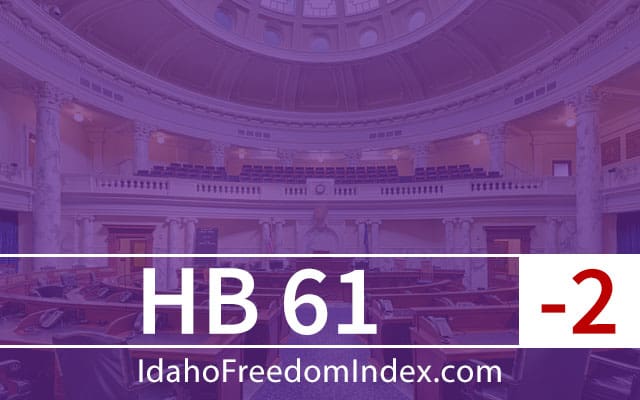


Bill description: HB 61 would establish a new corporate welfare program for small railroad companies investing in their infrastructure.
Rating: -2
Does it increase government redistribution of wealth? Examples include the use of tax policy or other incentives to reward specific interest groups, businesses, politicians, or government employees with special favors or perks; transfer payments; and hiring additional government employees. Conversely, does it decrease government redistribution of wealth?
HB 61 would give well-connected railroad companies special perks under the law. The new program created through this legislation would give Class II and Class III railroads—a railroad which has total carrier operating revenues of less than $450 million—a substantial tax break. The program would sunset five years after implementation. Conspicuously, this bill leaves out the few Class I rail carriers, such as Union Pacific and BNSF Railway, which also have track in Idaho.
The smaller rail companies operating in Idaho would receive a tax credit worth 40 percent of the investments they make into any new rail infrastructure. The credit would be capped at $3,500 for each mile of track that is developed. In addition, these companies could deduct these investments as general business expenses. Allowing these companies to take both the credit and the deduction would allow them to lower their total tax liability twice for the same expenses.
HB 61 would also allow a company that receives a tax credit but does not need its full value to offset its tax liability to transfer it to another Idaho taxpayer. The legislation thus creates a secondary market for rail tax credits, further increasing the favor the legislation bestows on rail companies. A railroad company that trades the tax credit to another company for discounted materials or other inputs would be obligated to use any savings to reinvest in its infrastructure.HB 61 benefits slightly more than a dozen companies at the expense of other taxpayers (one company alone operates more than half of the eligible track in Idaho). Based on the 885 miles of track that qualify, these few companies could receive a total of roughly $3 million in tax breaks in just the first year of this program’s implementation.
(-1)
Does it violate the principle of equal protection under the law? Conversely, does it restore or protect the principle of equal protection under the law?
This legislation benefits a few companies at the expense of others. When such policies are implemented, they distort the marketplace, undermine public trust in elected officials and create an unfair playing field for businesses. The fundamental problem with carveout tax credits is that they reward companies that are able to use the political system to their advantage and gain preferential tax treatment over other businesses without this access. Furthermore, bleeding off tax revenues through selective tax credits makes it more difficult to reduce the overall tax level. These tax credits are justified based on incremental economic activity from the affected industry, but there is no evaluation of what other industries would do if they got $3 million in tax credits.
(-1)
Analyst’s Notes:
House Bill 61 is an update of House Bill 375, which passed the House during the 2018 session but failed to get a hearing in the Senate. The changes from House Bill 375 to House Bill 61 are NOT substantial enough to improve the bill rating and are as follows:

